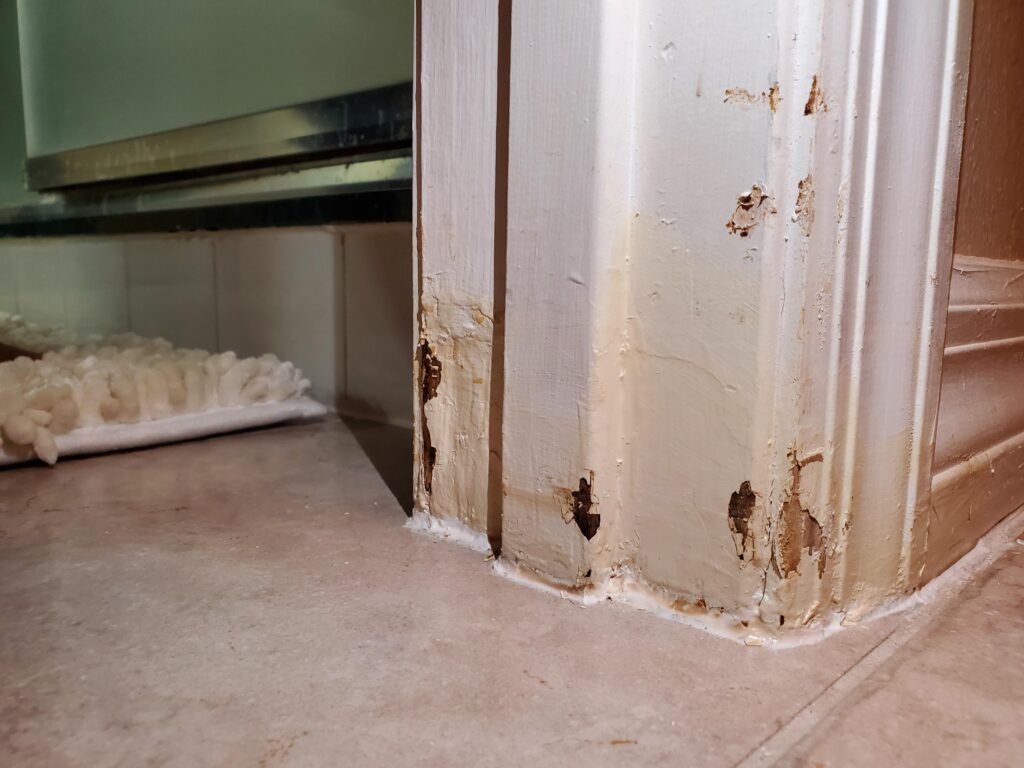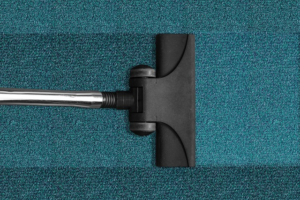A wood door is a gorgeous addition to any home. In high-humidity areas, however, or places with heavy rainfall, it can be easy for your wood doors to suffer water damage.
The water-damaged wood door could become structurally unsound, swollen, and unusable if left alone.
Don’t start looking for a door replacement immediately – if water exposure is recent enough, it might be possible to repair water damage on the wood yourself.
Signs Your Door Has Water Damage
If your doors, or other type of wood infrastructure, were damaged by heavy rains, flooding or a sewage backup, tackling repairs could be dangerous. In those cases, it’s best to replace your door altogether and call a restoration company to decontaminate the rest of your home.
But on a wood door exposed to moisture over time? You can flex your carpentry skills.
A few telltale signs of water damage to your door include:
- stains and discoloration
- warping
- swelling
- peeling or sagging paint
- wood crumbling
Water stains are the most straightforward type of water damage to repair on a door, as they may only need to be wiped off.

How to Repair a Water-Damaged Wood Door
If your door is made of wood, it doesn’t take much moisture to cause water damage. Let’s get into the specifics of how to repair water damage on your door.
Find What Caused the Damage to Your Door
Before starting to repair water damage on your door, you need to fix the source of moisture that damaged the wood in the first place to prevent further damage in your house.
Oftentimes, water damage on a wood door can have much more subtle origins than standing water and sagging furniture caused by heavy rain, flooding, and even sewer backups, and instead can build over time because of humidity, bad gutters, and small leaks.
If you can’t find the source, call our team. We can inspect your home’s structure and plumbing to track the damaged area. Our teams have more experience with leaks and can recognize signs homeowners might miss.
Remove As Much Moisture As Possible From The Room
Set up dehumidifiers, run fans, and open all windows and doors to air out the space as quickly as possible.
Check if any other items in the damaged area were impacted and remove them. Inspect everything – rugs, mats, clothing, furniture, and decor, so the air is as dry as possible.
Clean the Door and Door Frame
Before you start repairing water damage, ensure the rest of the door is clean.
This is also a great time to inspect for mold along any compromised wood on the door– you don’t want to trap dirt, debris, or other contaminants under new paint and sealing.
If some debris is trapped in the wood, don’t be afraid to scrape it away. You’ll repair all of this damage later in the process by sanding, painting, and sealant the door.
Sand it Down
Next, sand the damaged areas of the door to prepare it for fixing, creating a smooth, level surface for new paint.
Use fine grit sand paper on the door to avoid causing further damage to the wood.
Prep The Area with Painter’s Tape
Before applying any sealant or paint to the wood, tape off the outside of the door and around any trim.
Also, tape around hardware like hinges and doorknobs to protect it, or remove them completely.
Important note: Make sure your rubber weather stripping is protected. Painting over the weather stripping can prevent it from flexing and sealing properly between your door and threshold, leading to more water and air leaks.
Seal the Wood With A Polyurethane, Varnish, Or Lacquer
To prevent damage in the future, take steps now to ensure all of your wood doors are properly sealed. Sealant extends the life-span of your door, protecting it from additional damage, as well as general wear and tear.
Start with a brush for more detailed areas, then switch to a roller. Move vertically, then horizontally, moving to the more detailed sections as you finish.
Starting with a brush ensures you get into those smaller areas, while the roller smooths the seal into a cohesive coating.
Apply Paint
Once the sealant is fully dry, you can start applying your paint. Using a high-quality acrylic paint is great for repelling water, preventing water damage down the line.
Note: if you are only working on a small portion of the wood door, you don’t have to coat the entire thing, just the area where you worked. Be sure to match your current color. If you can’t, you may need to sand and treat the entire door for a uniform appearance.
How to Prevent Water Damage to Wood Doors
Before water exposure ever happens on your property, there are steps you can take to prevent water damage in the first place. To prevent a water damaged wood door in the future:
- On darker woods, tung, teak, or linseed oil to weatherproof
- Install a storm door
- Regularly inspect for nearby leaks or cracks
- Ensure all gutters and downspouts are properly placed
- Use moisture monitors in high-humidity rooms for early warning
Your FAQs Answered By the Pros
What should I do if I find wood rot on my door?
Unfortunately, if you pull your door down for repair and realize it has already begun to rot, it’s too late to salvage it. Your door is likely no longer structurally sound, and you should replace it instead of attempting to fix the damaged wood.
Will swollen wood doors shrink?
Swelling on any door is generally caused by excess moisture. As the wood dries, you should notice the swelling go down. The time this takes can vary by the amount of water, the time exposed, and what type of wood your door is made of.
Unfortunately, your water-damaged door may not shrink back to its original size. If the damaged wood makes it difficult to open or close your door, you may need to replace it. You need functioning doors to protect your home— and the people living there.
Are water stains permanent on my wood doors?
Absolutely not! Removing stains to repair your water-damaged wood door is a relatively simple process. With the right time and tools, you can easily repair water stains, and be sure to give it a coating of oil or sealing to protect it from future damage.
How long does it take for water to ruin wood on doors?
Untreated moisture damage can lead to rot in as little as six months. Once your door begins to rot, it’s beyond repair and should be replaced.
If you suspect your wood is not sealed correctly, give the door a coating to protect it.
Is there a difference between working with interior doors and exterior doors?
Yes. Exterior doors need a heavy-duty primer for proper protection, and interior ones generally won’t have weather stripping. Other than that, the repair process is the same.
For Stress-Free Water Restoration, Turn To The Professionals
While it is possible to fix a water damaged door on your own, any water damage at all can indicate a deeper structural issue in your home.
After a water damage or flooding event, always call a professional water restoration company to ensure your home is free from any mold, contamination, and structural damage that can arise from water intrusion.
TN Flood Kings will immediately dry out damaged rooms, disinfect for mold and mildew, and start the restoration process, taking much of the burden off your shoulders. Get a quote, or call our 24/7 emergency line at 615-477-9968.








